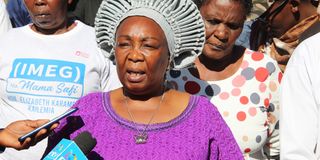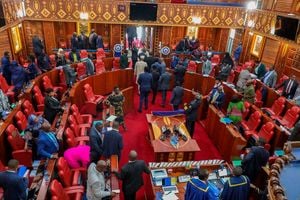Meru records highest number of teen pregnancies in the country

Meru Woman Rep Elizabeth Kailemia during the interview at Mwerongondu Primary school in Igembe North on August 25, 2023. She organised sensitisation to the rising teenage pregnancies in the county. Igembe North has reported the highest number of teenage pregnancies over the last seven years.
What you need to know:
- A survey shows that between January and May, out of 15,389 expectant mothers who sought antenatal care, 3,998 were adolescents aged between 10 and 19.
- Alarmed by the statistics, stakeholders have launched programmes to stem the rising number of teenage pregnancies.
Janet Kananu* recalls that when she got pregnant at the age of 17 while in Form Three, she did not know how to break the news to her widowed mother.
She waited until the pregnancy was visible, with her mother having suspected that all was not well. The mother of four children – whose husband died while Janet was just three years old – was so shocked that she did not even reprimand her.
“When the man who used to work as a guard learnt that I was pregnant, he vanished and cut off all communication, leaving me suffering with my pregnancy,” Janet says at her home in the Mwerongondu area of Igembe North, Meru County.
She gave birth to bouncing twins – a boy and a girl – ushering in a phase of her life characterised by anguish, fear and anxiety. What is usually a bundle of joy for a mother was Janet’s cause of misery and a shattered dream of becoming a nurse.
Despite the misfortune, she sat her Kenya Certificate of Secondary Education (KCSE) examination and obtained grade C plain. Today, she does manual jobs in Laare town, where she has rented a room. And she fears men.
Talking with several other girls who fell pregnant in Igembe North, one discovers that Janet is just one in a multitude of shocking statistics.
A National Syndemic Diseases Control Council (NSDCC) survey shows that between January and May, out of 15,389 expectant mothers who sought antenatal services in Meru, 3,998 were adolescents aged between 10 and 19, representing 26 per cent, the highest rate of teenage pregnancies in the country.
Over the last seven years, about four in 10 pregnancies at the first antenatal clinic was an adolescent aged 10–19. NSDCC Eastern regional coordinator Julius Koome said the teenage pregnancy trend started before Covid-19, and has never gone down.
While in 2016 the number of girls was 9,414 out of 35,068, representing 27 per cent, in 2017 it rose to 13,346 out of 32,238, or 41 per cent. In 2018, the figure further rose to 15,346, representing 45 per cent of the total 35,919 pregnancies.
But it is the number of girls aged under 14 years that raised the alarm. During Covid-19 crisis in 2020, the number of girls between 10 and 14 years who fell pregnant rose to 1,341 from 473 in 2019, while in 2021 the figure fell slightly to 1,113 in the same age bracket.
While last year the number of girls aged 10-19 who fell pregnant was 10,561 out of 34,808, representing 30 per cent, this year’s January–May data indicate that if the trend is not checked, the figures are likely to hit over 50 per cent.
According to the survey, 10 out of the 45 Meru County wards account for 53 per cent of all adolescent pregnancies reported in 2022. They are Amwathi (Igembe North), Kangeta (Igembe Central), Mikinduri (Tigania East), Maua (Igembe South), Muthara (Tigania East), Ntunene (Igembe North) Mwanganthia and Abogeta East (both in Imenti Central) and Municipality (Imenti North).

Reformed circumcisers campaign against FGM at Mwerongondu Primary School in Igembe North on August 25, 2023.
Alarmed by the statistics, the NSDCC, Woman Representative Elizabeth Kailemia and other stakeholders have launched programmes to stem the rising number of teenage pregnancies. Ms Kailemia says the factors contributing to the high rate of teenage pregnancies, especially in Igembe North, include poverty, neglect by parents and female genital mutilation (FGM).
“While poverty levels are very high in these areas, parents have also abdicated their duty. Once girls have been circumcised, they are encouraged to seek suitors for marriage, which is neglect. We also want the authorities to be ruthless on men who engage in sex with underage girls but go scot-free,” Ms Kailemia said, adding that miraa (khat) trade is also to blame.
“Our research has also shown that the men responsible for the pregnancies are teenagers. These are young boys who engage in miraa trade and lure vulnerable girls into sex as they have money. Our sensitisation campaigns are also targeting these young men,” she added, stressing that they are also giving sanitary pads to girls to prevent them from seeking favours from men.
To discourage FGM, the woman rep has roped in circumcisers who have since abandoned the practice.
Ms Tabitha Nchororo from Igembe North, who was introduced to the trade at the age of 13 by her grandmother after she underwent the cut, says she has since quit the practice and joined anti-FGM crusaders with a view to discouraging young girls from being circumcised.
“After undergoing the rite at an early age of 11 years, the girls are told that they are now adults and encouraged to engage in sex with older men. This is what we are discouraging because it is ruining our girls,” she said.
Mr Koome said NSDCC would step up sensitisation, adding that the Meru case was a disaster. “These girls are children and we are shocked they are engaging in sex at that age. We will not allow this to continue and the council will take necessary measures to stop it,” he said.
*Name changed to protect identity.





